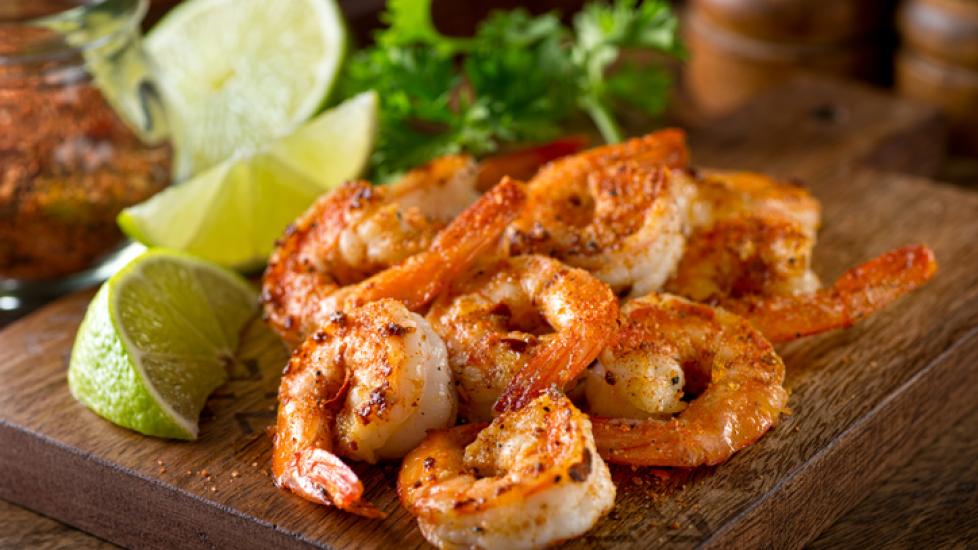Can Dogs Eat Shrimp?
NOTE: Always check with your veterinarian first before giving your dog any new foods, especially “people foods.” What might be OK for one dog might not be good for your dog, depending on multiple factors, such as their age, health history, health conditions, and diet. Dogs on prescription diets should not be fed any food or treats outside the diet.
Can dogs eat shrimp? The answer is yes—shrimp are not only safe for dogs to eat, but they can also be nutritious. Find out the proper portions, tips for cooking shrimp, and health benefits of feeding shrimp to your dog.
Is Shrimp Bad for Dogs?
When prepared properly, shrimp is safe for dogs and puppies to eat in small portions. Shrimp does contain a high amount of cholesterol and sodium.
Make sure that the shrimp is thoroughly cooked, and always remove the shell, veins, and tail. The shells can become a choking hazard or even lead to an intestinal blockage. And if the shrimp is not properly cooked, the bacteria found in shrimp can give your dog shellfish poisoning.
Can Dogs Be Allergic to Shrimp?
It’s unlikely that your dog would be allergic to shrimp if they’ve never had it before. Allergies usually develop from long-term exposure to a food. However, a food intolerance can happen the first time your dog eats something, so they may be intolerant to shrimp. If so, they may have diarrhea or vomiting.
Can Dogs Eat Raw Shrimp?
Dogs should not eat raw shrimp. Uncooked shellfish contain pathogens, like bacteria, which can make your dog sick with shellfish poisoning. If your dog has eaten raw shrimp, watch for the following symptoms:
-
Diarrhea
-
Vomiting
-
Nausea
-
Abdominal pain
If you notice any of these symptoms in your dog, take them to your veterinarian immediately.
Can Dogs Eat Cooked, Boiled, or Fried Shrimp?
Dogs should only eat cooked shrimp. You can use any of the following methods to cook shrimp for your pup:
-
Boil
-
Steam
-
Grill
-
Bake
However, the shrimp shouldn’t be cooked with the seasoning that you would use if you were making shrimp for people. Do not add butter, oils, fats, seasonings, or spices. These are all unhealthy additions for your dog. Garlic and onions are also toxic to dogs.
Things like coconut shrimp, shrimp tempura, and sautéed shrimp contain all sorts of added ingredients that are not healthy for your dog. And this may cause them to have stomach problems.
Is Shrimp Good for Dogs?
There are many health benefits to adding shrimp to your dog’s diet. Your pup will love the taste, but shrimp is a high-protein, low-calorie snack that also has vitamins, minerals, and nutrients, including:
-
Vitamin B12
-
Niacin
-
Phosphorus
-
Potassium
-
Magnesium
-
Iodine
-
Antioxidants
-
Omega-3 fatty acids
How Many Shrimp Can Dogs Eat?
Any treats you feed your dog should only make up 10% of their diet. The other 90% should come from a well-balanced dog food diet. And yes, this still applies to healthy treats like shrimp.
Check out the general guidelines below for safe shrimp feeding portions based on your dog’s weight and breed size.
-
Extra-small dog (2–20 pounds) = 1/2 medium shrimp
-
Examples: Yorkies, Chihuahuas, Pomeranians, Pugs, Shih Tzus
-
-
Small dog (21–30 pounds) = one medium shrimp
-
Examples: Basenjis, Beagles, Miniature Australian Shepherds
-
-
Medium dog (31–50 pounds) = two medium shrimp
-
Examples: Basset Hounds, Border Collies, Australian Cattle Dogs, Siberian Huskies
-
-
Large dog (51–90 pounds) = three medium shrimp
-
Examples: Pit Bulls, German Shepherds, Labrador Retrievers, Australian Shepherds
-
-
Extra-large dog (91+ pounds) = up to four medium shrimp
-
Examples: Newfoundlands, Bernese Mountain Dogs, St. Bernards, Great Pyrenees
-
If your dog accidentally eats too much shrimp, keep an eye out for the following symptoms of an upset stomach. If you notice any of these symptoms, contact your veterinarian right away:
-
Decreased appetite or loss of appetite
-
Fatigue
-
Acting depressed
-
Looking uncomfortable
-
Gulping or licking their lips, the air, or objects
If you notice any of these more serious symptoms, take your dog to the vet immediately:
How to Safely Feed Your Dog Shrimp
Purchase high-quality shrimp from a reputable seafood distributor or seller.
Remove the shells, veins, and tails. Whether you boil, bake, steam, or grill the shrimp, it should be cooked all the way through. Do not use butter, oils, fats, spices, or seasonings. Cut the cooked shrimp into small pieces.
Here are some ways you can serve shrimp to your dog:
-
Mix the shrimp pieces in with your dog’s regular food.
-
Make a special treat by mixing the cooked pieces of shrimp with other cut-up, cooked pieces of dog-safe vegetables like potatoes, carrots, sweet potatoes, green beans, peas, or broccoli.
-
Mix some cut-up, cooked pieces of shrimp with plain, cooked rice. You can even stuff these mixtures into your dog’s KONG toy to keep them busy as they dig it out.
Featured Image: iStock.com/Fudio
Help us make PetMD better
Was this article helpful?
